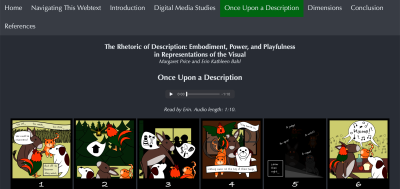Consider this scene from a folktale: “Four animals sit in a circle in a grassy field: a donkey, a cat, a dog, and a rooster. A banner above them reads ‘Too old ... too weak ... too slow.’ The donkey then gets an idea represented by a speech bubble that says, ‘We could be musicians!’ A text box at the bottom of the frame reads, ‘And off to Bremen they went.’” After reading this description perhaps an image has been conjured in your mind of the four animals all sitting together as they plan to go off to Bremen. This detailed description allows users to get a clear image in their minds of the story that is being told without the use of a visual image.

Alumna Erin Kathleen Bahl and Associate Professor and Director of Disability Studies Margaret Price chronicle The Bremen Town Musicians by the Brothers Grimm in their webtext, The Rhetoric of Description: Embodiment, Power, and Playfulness in Representations of the Visual. In 2023 Price and Bahl won the Kairos Best Webtext Award for their work after Ohio State alum Remi Yergeau nominated the pair for the award.
Their webtext aims to explore audio description (AD), which Bahl and Price define as “a range of techniques aimed at making visual media, including still images, videos and live performances, more accessible.” Their work also highlights “some of the complex technical and ethical questions that enter into various applications of AD.” Over the course of five years Bahl and Price embarked on a journey to create The Rhetoric of Description that allowed them to creatively explore audio description. The two first met in 2016 at the Department of English Digital Media and Composition Institute (DMAC).

Price recalls that visit to DMAC, “I saw that there was just so much potential beyond what I had already been doing, in terms of being able to actually think through audio description as an act of digital composing and invention.” She had done previous work with audio description, but DMAC introduced her to a new world of opportunities. There Price was introduced to Bahl, who had been working as a graduate student and associate director of DMAC at the time. The topic of webtext creation had also been a focus for Bahl in her dissertation work. “Erin is just brilliant, it’s immediately obvious when you work with her just how beautiful her work is and how thoughtful she is,” Price praises.
The connection was instant and the two started having conversations about working on a project together, a project that would delve into the intersection of invention and accessibility. Bahl recalls her initial thoughts of Price upon their first meeting. She remembers thinking, “This is the kind of person who would be awesome to collaborate with and we could really create a cool project together.” The initial brainstorming for a collaborative project began in January 2017. This project would allow both Price and Bahl to bring the work they had already been doing with accessibility and webtext creation together in a brand-new way. “We knew from the start that it would be a webtext,” Price explains, as their collective knowledge and Bahl’s technical and artistic skills would combine to create The Rhetoric of Description.
Some of the earliest pieces of The Rhetoric of Description that they worked on were the images created by Bahl to go along with their chosen story, The Bremen Town Musicians. As Bahl explains, the images were “one of the things that really solidified,…the kind of thing that’s stayed probably the most consistent throughout the project.” The use of the Brothers Grimm fairytale allowed Price and Bahl to explore audio description through an illustrated retelling of the story. This approach to the topic was key; as Price explains, “audio description is inventive and creative, and we should approach it that way.”
The rest of the webtext and argument started to form around the image components as Price and Bahl continued to work on the webtext each year. “We were kind of still touching on the ideas in different ways but didn’t quite have the capacity at the time to really dive into them as much as we wanted,” Bahl explains. An initial struggle for the project was the amount of time each person was able to dedicate to the webtext, as both Price and Bahl were juggling various responsibilities in their own lives. “We were really honest with each other when we needed breaks,” Price says. Bahl agrees and notes that this was “a process that required a lot of time and kindness, and Margaret was definitely there with all of that.”
The webtext continued to take shape as Price and Bahl went through various revisions and edits. “It got really challenging as we went along to realize, how do we design something that is truly accessible, that really welcomes every user we can think of, but isn’t just like boring and simplistic,” Price says. Price and Bahl had to carefully consider all features that they added to the webtext to make it as accessible as possible. Bahl remembers these challenges in reflecting on an earlier draft of the webtext: “It might look shiny and fun, but for someone navigating this from an audio perspective it is not working.” Price further explains, “Not only is audio description inventive and creative, but you cannot describe any text, whether it's a movie or a video or a still image…without involving dynamics of power and privilege.” The webtext became more interactive and included various elements to explore the different levels of description. “I knew that the idea would become so much richer and more true to what description really is if it were presented as a multimodal composition,” Price says.
The webtext features images, text and audio all to help users navigate the story and the argument of Price and Bahl’s work. “Audio description, it's creative, it's inventive. When you’re doing any kind of accessibility work it's not just about minimalist, ‘here is how I’ve checked all the boxes on this list for this category’, but to have fun with it and play with it,” Bahl says.

The first draft of The Rhetoric of Description was completed in 2020 and after being sent off to Kairos for review the final version was published in 2022. “This is not something either of us could have composed on our own, it had to be a collaborative project,” Price says. Price and Bahl were able to overcome their initial barriers to create a webtext that allowed them to explore a variety of topics to show users the innovation of audio description. Price acknowledges the uniqueness of this project: "this is one of the only departments I can think of anywhere, where this particular project could have been born and come to fruition.” Throughout their time Price and Bahl created the webtext by working with topics such as disability studies, fairytale studies and folklore. Bahl describes, “This is probably a project that also is unique to Ohio State, in the sense of the disciplines, us bringing together with digital media, disability, with comics, with narrative, with folklore…with kind of all of these dimensions.”
Through this process Price and Bahl found a supportive work partner in one another. Bahl reflects on her work with Price, “I appreciated the chance to be mentored through that process of creating a very robust, multifaceted, very precise and very ethical piece of scholarship.” Price echoes her gratitude, “I really could not ask for someone who’s a better colleague, not only in terms of being knowledgeable and hardworking, but also very kind and just with really good boundaries.”
The supportive partnership that allowed Bahl and Price to create this webtext also extends to the webtext itself. Users of their webtext can navigate the site to explore how the pair used audio description creatively to tell a story and highlight the importance of accessibility. Price says, “I hope that this is a topic that people feel genuinely invited into and interested in.”
